英语:情景交际知识点
- 格式:docx
- 大小:37.26 KB
- 文档页数:4
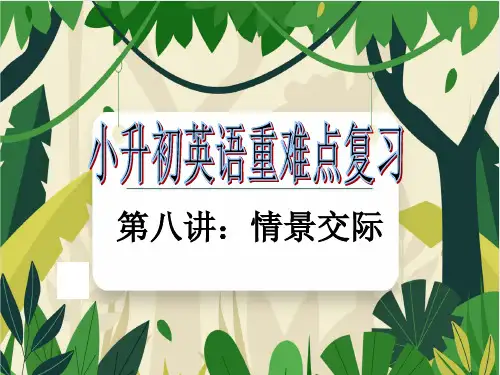
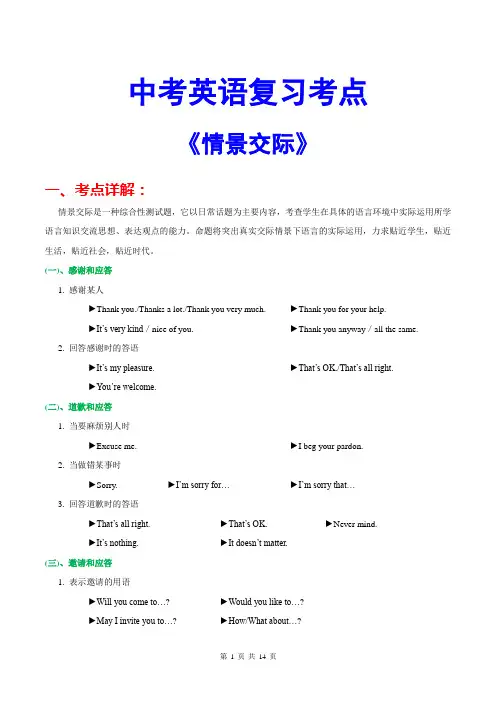
中考英语复习考点《情景交际》一、考点详解:情景交际是一种综合性测试题,它以日常话题为主要内容,考查学生在具体的语言环境中实际运用所学语言知识交流思想、表达观点的能力。
命题将突出真实交际情景下语言的实际运用,力求贴近学生,贴近生活,贴近社会,贴近时代。
(一)、感谢和应答1. 感谢某人►Thank you./Thanks a lot./Thank you very much. ►Thank you for your help.►It’s very kind/nice of you. ►Thank you anyway/all the same.2. 回答感谢时的答语►It’s my pleasure.►That’s OK./That’s all right.►You’re welcome.(二)、道歉和应答1. 当要麻烦别人时►Excuse me. ►I beg your pardon.2. 当做错某事时►Sorry. ►I’m sorry for…►I’m sorry that…3. 回答道歉时的答语►That’s all right.►That’s OK. ►Never mind.►It’s nothing.►It doesn’t matter.(三)、邀请和应答1. 表示邀请的用语►Will you come to…? ►Would you like to…?►May I invite you to…? ►How/What about…?2. 接受邀请时的答语►Yes, I’d like /love to.►Yes. It’s very kind of you.►That would be nice.3. 拒绝邀请时的答语►No, thank you. ►I’d love /like to,but…(四)、请求和应答1. 表请求用语►May I…? ►Can/Could I…? ►Would you mind if…?2. 表肯定的答语►Sure. /Certainly. ►Yes, do please.►That’s all right.►Of course, you can.3. 表否定的答语►I’m afraid not.►I’m sorry, but you mustn’t/can’t.►You’d better not.(五)、祝愿、祝贺和应答1. 祝贺用语►Have a good day/time! ►Have a good journey/trip!►Good luck! ►Enjoy yourself!►Best wishes to you! ►Happy New Year!►Merry Christmas! ►Happy birthday!►Congratulations! ►Well done!2. 应答用语►Thank you. ►You, too. ►The same to you.(六)、提供帮助和应答1. 提供帮助►Can I help you? ►Would you like me to help you?►What can I do for you? ►Let me help you.2. 肯定答语►Yes, please./Yes, thanks. ►Thank you for your help.►Thank you. ►That would be nice.3. 否定答语►No, thanks/thank you. ►That’s very kind/nice of you, but I can manage it myself.(七)、劝告和建议►You’d better…►Why not…?►How/What about…? ►Shall we…? ►You shouldn’t…(八)、打电话1. 拨电话方的交际用语►Could/May/Can I speak to...please? ►Who’s that(speaking)?►This is…(speaking). ►Could you ask him/her to call me back?►I’m calling to tell/ask you to…2. 接电话方的交际用语►Hold on(for a moment), please.►I’m sorry/afraid he’s/she’s out at the moment/right now.►Can I take a message (for you)?(九)、购物1. 营业员常用的交际用语►CanI help you?/What can I do for you? ►How many/much… do you want?►What about this one? ►What colour/size/kind do you like/want?►I’m afraid we haven’t got any…in that siz e at the moment.►Here you are.2. 顾客常用的交际用语►I want /would like to buy some. . . (for. . . ) ►I’m looking for. . .►I would like/want two kilos of... ►I like the colour,but it’s/they’re too. . .►It’s great,but it’s not. . . enough.►Have you got any other kind/colour/size?►That looks nice/great. ►Have you got anything cheaper?►How much does it cost? ►Can/May I try them/it on,please?(十)、看病1. 医生常用交际用语►What’s wrong with you? /What’s tihe matter?/What’s up?►How long have you been like this? ►Have you taken your temperature?►Have you had anything to eat this morning?►There’s nothing serious.►Take this medicine and stay in bed for a few days.►You will get better soon. ►You will be all right/well soon.2. 病人常用的交际用语►I have got a headache/cough.►I’m not feeling well./l don’t feel very well./I feel terrible►There’s something wrong with...(十一)、情感1. 高兴►How wonderful/nice! ►That’s lovely/great/wonderful!►I’m pleased to know that.2. 惊奇►Really? ►Oh dear!►Is that so? ►What a surprise!►How nice to see you! ►How surprising!►I’m surprised.3. 满意►Good! ►Well done! ►Perfect!►That’s fine.►That’s better.►That’s good enough.4. 忧虑►What’s wrong?►What’s the matter?►Anything wrong? ►What should we do?5. 遗憾与同情►I’m so sorry!►It’s a great pity!►What a shame/pity! ►That’s too bad!►I’m sorry to hear that.二、分法技巧:情景交际题之解题思路要做好这类题目,关键是平时要养成讲英语的良好习惯,努力提高口语水平,熟练掌握日常会话项目中常用的问答语。
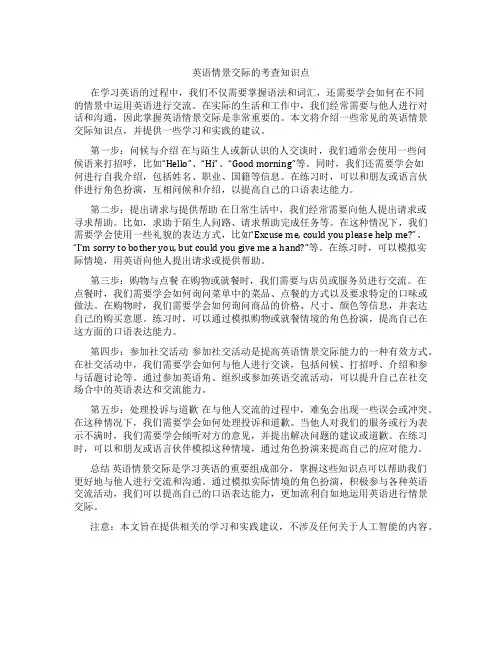
英语情景交际的考查知识点在学习英语的过程中,我们不仅需要掌握语法和词汇,还需要学会如何在不同的情景中运用英语进行交流。
在实际的生活和工作中,我们经常需要与他人进行对话和沟通,因此掌握英语情景交际是非常重要的。
本文将介绍一些常见的英语情景交际知识点,并提供一些学习和实践的建议。
第一步:问候与介绍在与陌生人或新认识的人交谈时,我们通常会使用一些问候语来打招呼,比如“Hello”、“Hi”、“Good morning”等。
同时,我们还需要学会如何进行自我介绍,包括姓名、职业、国籍等信息。
在练习时,可以和朋友或语言伙伴进行角色扮演,互相问候和介绍,以提高自己的口语表达能力。
第二步:提出请求与提供帮助在日常生活中,我们经常需要向他人提出请求或寻求帮助。
比如,求助于陌生人问路、请求帮助完成任务等。
在这种情况下,我们需要学会使用一些礼貌的表达方式,比如“Excuse me, could you please help me?”、“I’m sorry to bother you, but could you give me a hand?”等。
在练习时,可以模拟实际情境,用英语向他人提出请求或提供帮助。
第三步:购物与点餐在购物或就餐时,我们需要与店员或服务员进行交流。
在点餐时,我们需要学会如何询问菜单中的菜品、点餐的方式以及要求特定的口味或做法。
在购物时,我们需要学会如何询问商品的价格、尺寸、颜色等信息,并表达自己的购买意愿。
练习时,可以通过模拟购物或就餐情境的角色扮演,提高自己在这方面的口语表达能力。
第四步:参加社交活动参加社交活动是提高英语情景交际能力的一种有效方式。
在社交活动中,我们需要学会如何与他人进行交谈,包括问候、打招呼、介绍和参与话题讨论等。
通过参加英语角、组织或参加英语交流活动,可以提升自己在社交场合中的英语表达和交流能力。
第五步:处理投诉与道歉在与他人交流的过程中,难免会出现一些误会或冲突。
在这种情况下,我们需要学会如何处理投诉和道歉。
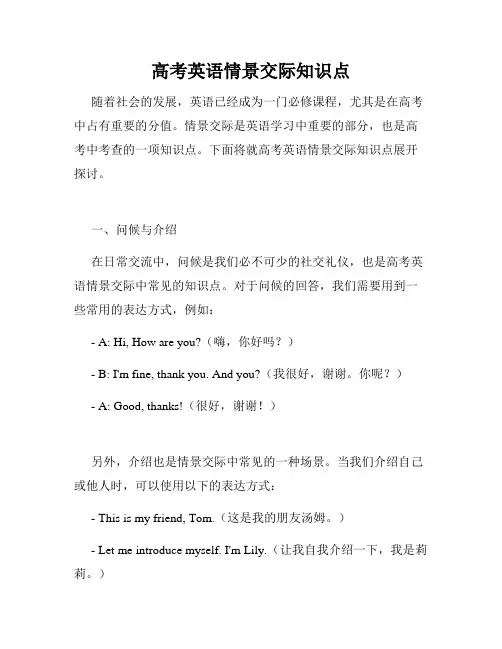
高考英语情景交际知识点随着社会的发展,英语已经成为一门必修课程,尤其是在高考中占有重要的分值。
情景交际是英语学习中重要的部分,也是高考中考查的一项知识点。
下面将就高考英语情景交际知识点展开探讨。
一、问候与介绍在日常交流中,问候是我们必不可少的社交礼仪,也是高考英语情景交际中常见的知识点。
对于问候的回答,我们需要用到一些常用的表达方式,例如:- A: Hi, How are you?(嗨,你好吗?)- B: I'm fine, thank you. And you?(我很好,谢谢。
你呢?)- A: Good, thanks!(很好,谢谢!)另外,介绍也是情景交际中常见的一种场景。
当我们介绍自己或他人时,可以使用以下的表达方式:- This is my friend, Tom.(这是我的朋友汤姆。
)- Let me introduce myself. I'm Lily.(让我自我介绍一下,我是莉莉。
)二、询问与回答问题在日常生活中,我们常常需要询问和回答一些问题。
以下是一些常见的询问与回答方式:- A: Can you tell me the way to the nearest supermarket?(请问,你能告诉我去最近的超市的路吗?)- B: Sure. Go straight and turn left at the second traffic light. It's on your right.(当然。
一直往前走,在第二个红绿灯处左转,它在你的右边。
)- A: What's the weather like today?(今天天气怎么样?)- B: It's sunny and hot.(天晴炎热。
)- A: How do you like the movie?(你觉得这部电影怎么样?)- B: I think it's great.(我觉得很好。
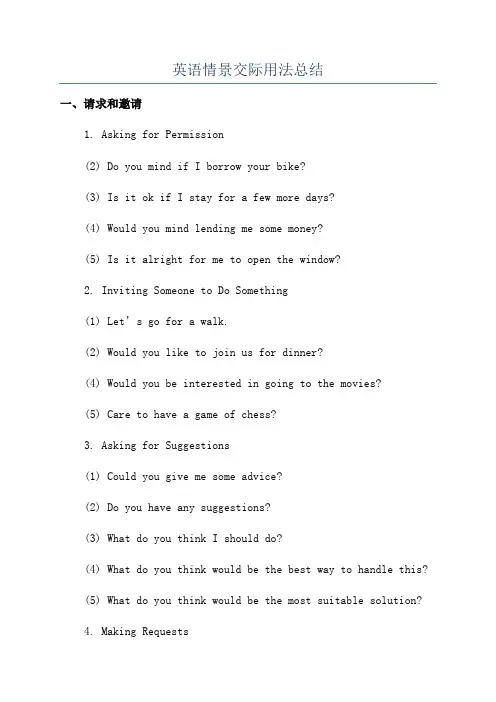
英语情景交际用法总结一、请求和邀请1. Asking for Permission(2) Do you mind if I borrow your bike?(3) Is it ok if I stay for a few more days?(4) Would you mind lending me some money?(5) Is it alright for me to open the window?2. Inviting Someone to Do Something(1) Let’s go for a walk.(2) Would you like to join us for dinner?(4) Would you be interested in going to the movies?(5) Care to have a game of chess?3. Asking for Suggestions(1) Could you give me some advice?(2) Do you have any suggestions?(3) What do you think I should do?(4) What do you think would be the best way to handle this?(5) What do you think would be the most suitable solution?4. Making Requests(1) Can you help me with my homework?(2) Could you please pass me the salt?(3) Could you do me a favor?(4) Would you mind giving me a hand?(5) Can you take a look at this for me?二、表示拒绝1. Polite Refusal(1) I’m sorry, but I can’t.(2) No, I’m afraid not.(3) I’m afraid it’s not convenient for me.(4) I’m sorry, I have other plans.(5) That’s very kind of you, but I can manage.2. Firm Refusal(1) I’m sorry, I won’t be able to do that.(2) No, I can’t do that.(3) I’m sorry, I won’t be able to take up your offer.(4) No, I’m afraid that’s out of the question.(5) I’m sorry, I have to refuse.三、表达感谢1. Expressing Gratitude(1) Thanks a lot.(2) I really appreciate it.(3) Thank you for your help.(4) Thanks for your kind assistance.(5) I’m very grateful for your hospitality.2. Accepting Thanks(2) It’s my pleasure.(3) Don’t mention it.(4) It’s nothing.(5) Glad to be of help.四、表达道歉1. Apologizing(1) I’m sorry about the mistake.(2) Please forgive me for my carelessness.(3) I apologize for my behavior.(4) I apologize for not being able to attend.(5) I apologize for any inconvenience caused.2. Accepting Apology(1) That’s alright.(2) Don’t worry about it.(3) It’s ok.(4) Don’t mention it.(5) That’s quite all right.五、表达鼓励1. Encouraging Someone(1) You can do it.(2) Hang in there.(3) You’re doing great.(4) I believe in you.(5) Keep it up.2. Accepting Encouragement(1) Thank you.(2) I really appreciate it.(3) That means a lot to me.(4) I’m glad to have your support.(5) You’ve given me the courage to go on.六、表达肯定1. Expressing Agreement (1) That’s a great idea.。
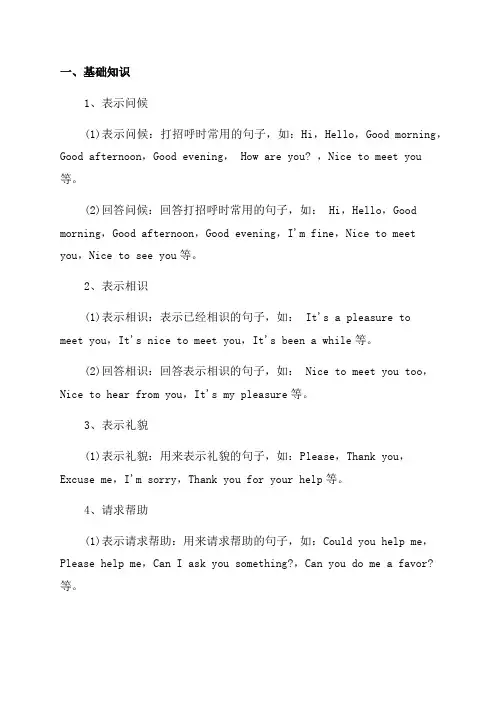
一、基础知识1、表示问候(1)表示问候:打招呼时常用的句子,如:Hi,Hello,Good morning,Good afternoon,Good evening, How are you? ,Nice to meet you等。
(2)回答问候:回答打招呼时常用的句子,如: Hi,Hello,Good morning,Good afternoon,Good evening,I'm fine,Nice to meet you,Nice to see you等。
2、表示相识(1)表示相识:表示已经相识的句子,如: It's a pleasure tomeet you,It's nice to meet you,It's been a while等。
(2)回答相识:回答表示相识的句子,如: Nice to meet you too,Nice to hear from you,It's my pleasure等。
3、表示礼貌(1)表示礼貌:用来表示礼貌的句子,如:Please,Thank you,Excuse me,I'm sorry,Thank you for your help等。
4、请求帮助(1)表示请求帮助:用来请求帮助的句子,如:Could you help me,Please help me,Can I ask you something?,Can you do me a favor?等。
(2)回答请求帮助:回答表示请求帮助的句子,如:Yes,Sure,What can I do for you?,I'll be glad to help,No problem等。
5、邀请(2)回答邀请:回答表示邀请的句子,如:Yes,I'd love to,Sure,I'd be happy to,No problem等。
6、表示感谢(1)表示感谢:用来表示感谢的句子,如:Thank you,Thanks a lot,Thank you for your help,I really appreciate it等。
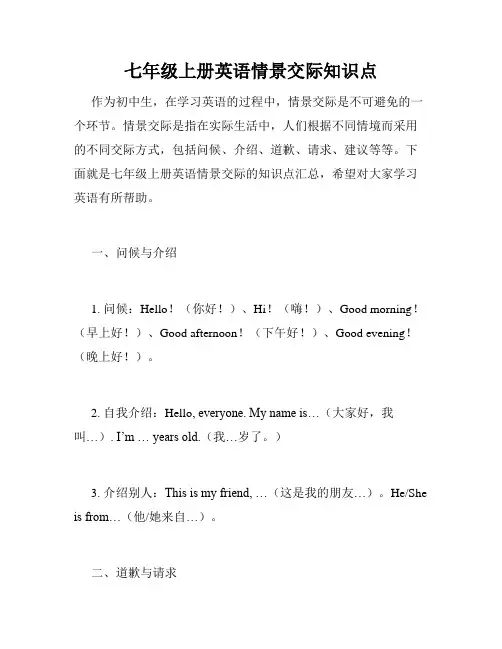
七年级上册英语情景交际知识点作为初中生,在学习英语的过程中,情景交际是不可避免的一个环节。
情景交际是指在实际生活中,人们根据不同情境而采用的不同交际方式,包括问候、介绍、道歉、请求、建议等等。
下面就是七年级上册英语情景交际的知识点汇总,希望对大家学习英语有所帮助。
一、问候与介绍1. 问候:Hello!(你好!)、Hi!(嗨!)、Good morning!(早上好!)、Good afternoon!(下午好!)、Good evening!(晚上好!)。
2. 自我介绍:Hello, everyone. My name is…(大家好,我叫…). I’m … years old.(我…岁了。
)3. 介绍别人:This is my friend, …(这是我的朋友…)。
He/She is from…(他/她来自…)。
二、道歉与请求1. 道歉:I’m sorry.(对不起。
)I’m really sorry.(真的很对不起。
)2. 请求:Can you…?(你可以…吗?)Could you…?(你能…吗?)。
三、点菜与购物1. 点菜:What would you like to order?(你想要点什么?)2. 购物:How much is it?(这多少钱?)Do you have…?(你们有…吗?)四、时间与约会1. 时间:What time is it?(现在几点了?)2. 约会:Would you like to go to a movie with me?(你想和我一起去看电影吗?)五、电话1. 接电话:Hello. This is…(喂,我是…)2. 打电话:(1)May I speak to…?(可以请…接电话吗?)(2) Can I leave a message?(我可以留言吗?)六、感谢与道别1. 感谢:Thank you.(谢谢。
)Thank you very much.(非常感谢。
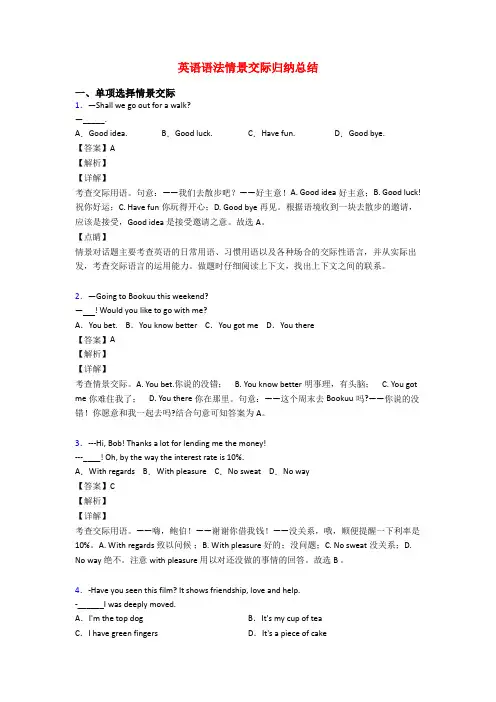
英语语法情景交际归纳总结一、单项选择情景交际1.—Shall we go out for a walk?—_____.A.Good idea. B.Good luck. C.Have fun. D.Good bye.【答案】A【解析】【详解】考查交际用语。
句意:——我们去散步吧?——好主意!A. Good idea好主意;B. Good luck! 祝你好运;C. Have fun你玩得开心;D. Good bye再见。
根据语境收到一块去散步的邀请,应该是接受,Good idea是接受邀请之意。
故选A。
【点睛】情景对话题主要考查英语的日常用语、习惯用语以及各种场合的交际性语言,并从实际出发,考查交际语言的运用能力。
做题时仔细阅读上下文,找出上下文之间的联系。
2.—Going to Bookuu this weekend?— ! Would you like to go with me?A.You bet. B.You know better C.You got me D.You there【答案】A【解析】【详解】考查情景交际。
A. You bet.你说的没错; B. You know better明事理,有头脑; C. You got me你难住我了; D. You there你在那里。
句意:——这个周末去Bookuu吗?——你说的没错!你愿意和我一起去吗?结合句意可知答案为A。
3.---Hi, Bob! Thanks a lot for lending me the money!---____! Oh, by the way the interest rate is 10%.A.With regards B.With pleasure C.No sweat D.No way【答案】C【解析】【详解】考查交际用语。
——嗨,鲍伯!——谢谢你借我钱!——没关系,哦,顺便提醒一下利率是10%。
A. With regards致以问候;B. With pleasure好的;没问题;C. No sweat没关系;D. No way绝不。
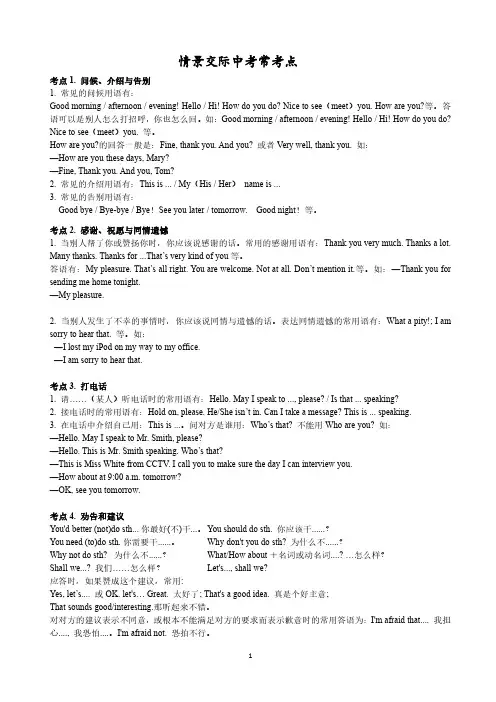
情景交际中考常考点考点1.问候、介绍与告别1.常见的问候用语有:Good morning/afternoon/evening!Hello/Hi!How do you do?Nice to see(meet)you.How are you?等。
答语可以是别人怎么打招呼,你也怎么回。
如:Good morning/afternoon/evening!Hello/Hi!How do you do? Nice to see(meet)you.等。
How are you?的回答一般是:Fine,thank you.And you?或者Very well,thank you.如:—How are you these days,Mary?—Fine,Thank you.And you,Tom?2.常见的介绍用语有:This is.../My(His/Her)name is...3.常见的告别用语有:Good bye/Bye-bye/Bye!See you later/tomorrow.Good night!等。
考点2.感谢、祝愿与同情遗憾1.当别人帮了你或赞扬你时,你应该说感谢的话。
常用的感谢用语有:Thank you very much.Thanks a lot. Many thanks.Thanks for...That’s very kind of you等。
答语有:My pleasure.That’s all right.You are welcome.Not at all.Don’t mention it.等。
如:—Thank you for sending me home tonight.—My pleasure.2.当别人发生了不幸的事情时,你应该说同情与遗憾的话。
表达同情遗憾的常用语有:What a pity!;I am sorry to hear that.等。
如:—I lost my iPod on my way to my office.—I am sorry to hear that.考点3.打电话1.请……(某人)听电话时的常用语有:Hello.May I speak to...,please?/Is that...speaking?2.接电话时的常用语有:Hold on,please.He/She isn’t in.Can I take a message?This is...speaking.3.在电话中介绍自己用:This is...。
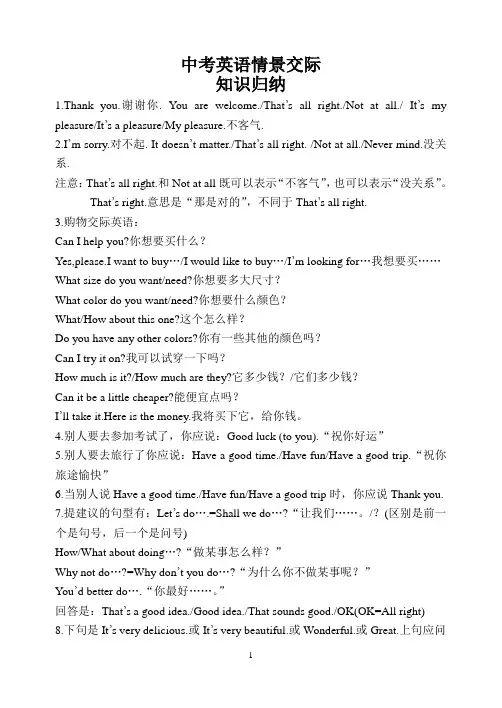
中考英语情景交际知识归纳1.Thank you.谢谢你. You are welcome./That’s all right./Not at all./ I t’s my pleasure/It’s a pleasure/My pleasure.不客气.2.I’m sorry.对不起. It doesn’t matter./That’s all right. /Not at all./Never mind.没关系.注意:That’s all right.和Not at all既可以表示“不客气”,也可以表示“没关系”。
That’s right.意思是“那是对的”,不同于That’s all right.3.购物交际英语:Can I help you?你想要买什么?Yes,please.I want to buy…/I would like to buy…/I’m looking for…我想要买……What size do you want/need?你想要多大尺寸?What color do you want/need?你想要什么颜色?What/How about this one?这个怎么样?Do you have any other colors?你有一些其他的颜色吗?Can I try it on?我可以试穿一下吗?How much is it?/How much are they?它多少钱?/它们多少钱?Can it be a little cheaper?能便宜点吗?I’ll take it.Here is the money.我将买下它,给你钱。
4.别人要去参加考试了,你应说:Good luck (to you).“祝你好运”5.别人要去旅行了你应说:Have a good time./Have fun/Have a good trip.“祝你旅途愉快”6.当别人说Have a good time./Have fun/Have a good trip时,你应说Thank you.7.提建议的句型有:Let’s do….=Shall we do…?“让我们……。
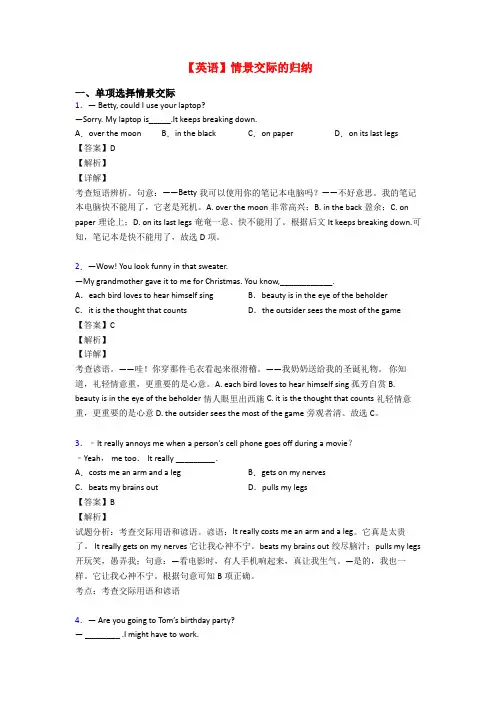
【英语】情景交际的归纳一、单项选择情景交际1.— Betty, could I use your laptop?—Sorry. My laptop is_____.It keeps breaking down.A.over the moon B.in the black C.on paper D.on its last legs【答案】D【解析】【详解】考查短语辨析。
句意:——Betty我可以使用你的笔记本电脑吗?——不好意思。
我的笔记本电脑快不能用了,它老是死机。
A. over the moon非常高兴;B. in the back盈余;C. on paper理论上;D. on its last legs奄奄一息、快不能用了。
根据后文It keeps breaking down.可知,笔记本是快不能用了,故选D项。
2.—Wow! You look funny in that sweater.—My grandmother gave it to me for Christmas. You know,____________.A.each bird loves to hear himself sing B.beauty is in the eye of the beholderC.it is the thought that counts D.the outsider sees the most of the game【答案】C【解析】【详解】考查谚语。
——哇!你穿那件毛衣看起来很滑稽。
——我奶奶送给我的圣诞礼物。
你知道,礼轻情意重,更重要的是心意。
A. each bird loves to hear himself sing孤芳自赏 B. beauty is in the eye of the beholder情人眼里出西施 C. it is the thought that counts礼轻情意重,更重要的是心意 D. the outsider sees the most of the game旁观者清。
英语:情景交际知识点情景交际题型特点:情景交际的考查目的主要在于考查考生对英语知识的理解及应用,从而检测出考生的英语驾驭能力。
这类题内容丰富,范围广,并无一定的模式。
每一个人对于交际中所出现的情形都无法预料,因此,考生在复习中应从以下几方面着手:1 •熟悉句型结构,增强理解能力;2•进行广泛阅读,积累各种情景中交际应酬的用语从而提高交际能力;3 •熟悉中、英两种文化差异,掌握两个不同民族的交际习惯方式:4•多看英文电视、电影,多跟外国人交谈,从而提高英语实际运用能力。
这类题虽然没有固定规律可寻,但只要交际能力提高了,解答这类题目就非常容易了。
情景交际试题命题方式:英语情景交际型试题主要考查考生对英语知识的理解和应用能力,考查考生对中西方文化差异的掌握情况及对英语的使用和驾驭能力。
在高考试题中,交际用语的考查相对集中,主要考查社会交往中的一些日常用语。
考查的方式以应答为主,提问为辅:以跨越文化交际中差异明显的交际项目为重点考查对象。
命题方式有以下几种:1、考查习惯应答语:许多情景对话中使用的是英美人的习惯用语。
问候、告别、打电话、纹路、看病、购物等常见的交际话题均有其较为固定的套语;感谢、道歉、祝愿、请求亦有其固定的应答用语。
2、考查文化差异语:汉语和英语在交际文化方面有许多共同之处,但也存在诸多差异。
这些差异往往是考查的重中之重。
避免母语交际定势的干扰,根据英语的文化交际习惯来应答是掌握文化差异的关键。
3、考查语言结构语:根据不同的交际用语,说话者回采用不同的交际用语来表达自己的态度和情感。
如当说话人对刚刚提出的说法或意见持肯定态度时,可以说:Yes, I thin k(suppose, believe) so./Yes, I'm afraid so.对刚刚提出的说法或意见持否定态度时,则说:No, I don't think (suppose, believe) so./No, I believe(soppose) not./No, I hope not. 要点知识点拨:常见的交际用语:1. Go ahead.(单独使用,表同意)行,可以。
情景交际知识点详解(初中英语专项复习)情景交际或者口语交际的主要考查形式是单选和补全对话,为中考必考点,同学们需要掌握英语中常见的日常生活英语表达。
常考话题如下:一、祝贺及祝福Have a nice trip. 祝你旅途愉快。
Congratulations. 祝贺你(得奖)。
Good luck! 祝你好运。
Nice work! Well done! 干得好!Have a nice day. 祝你玩儿得愉快。
Best wishes to you! 向你致以美好的祝愿!答语:Thank you. / Thanks a lot. /Thanks.如果是节日祝福如Happy new year! /Merry Christmas! 答语:The same to you.二、请求May I …? Can / Could I…? 我能……吗?Would you mind doing sth? Would you mind if…? 你介意……吗?肯定回答:Yes/ Sure/ Certainly. Of course (you can).That’s OK. All right. No problem.否定回答:I’m sorry, you can’t. Sorry, I’m afraid not. You’d better not.May I …?的否定回答是No, you mustn’t/ can’t.三、道歉、遗憾I’m sorry. I’m sorry for/ about that. I’m sorry that I’m late.道歉的答语:That’s all right. / It doesn’t matter. / Not at all. / That’s OK. 没关系。
Never mind.别介意。
Don’t worry about it. 别担心它。
Forget it.没关系,算了吧。
情景交际用语知识点总结一、问候与介绍1. 问好- Hello, how are you?- Hi, how’s it going?2. 自我介绍- Let me introduce myself. I’m Anna.- Hi, I’m David. Nice to meet you.3. 问候朋友- How have you been?- Long time no see. How are you doing?4. 介绍朋友- This is my friend, Mike.- Have you met my colleague, Sarah?二、打招呼与道别1. 打招呼- Good morning/ afternoon/ evening.- Hey, how’s everything?2. 道别- See you later.- Goodbye, take care.三、请求与允许1. 请求- Could you please help me with this?- Would you mind passing me the salt?2. 允许- Sure, no problem.- Of course, go ahead.四、感谢与回应1. 表示感谢- Thank you so much for your help. - I really appreciate it.2. 回应- You’re welcome.- No problem, glad to help.五、表达喜欢与不喜欢1. 喜欢- I really like this restaurant.- I’m a big fan of jazz music.2. 不喜欢- I don’t care for spicy food.- I’m not too keen on horror movies.六、表达赞同与不赞同1. 赞同- I totally agree with you.- That’s a great idea.2. 不赞同- I’m not sure I agree with that.- I’m afraid I have to disagree.七、请求和提供帮助1. 请求帮助- Could you please help me carry this?- Can you give me a hand with this?2. 提供帮助- Let me help you with that.- Do you need any assistance?八、询问与解释1. 询问- Could you tell me how to get to the nearest bank? - Do you know where the restroom is?2. 解释- That’s a long story, let me explain.- Let me clarify what I meant.九、道歉与原谅1. 道歉- I’m really sorry for being late.- Please forgive me for my mistake.2. 原谅- It’s okay, don’t worry about it.- I forgive you, no hard feelings.十、讨论和商议1. 讨论- Let’s discuss the details of the projec t.- I’d like to talk about our plans for next week.2. 商议- Let’s negotiate a better deal.- Can we come to an agreement on this issue?十一、祝福与祝愿1. 祝福- Best wishes on your birthday.- Good luck with your new job.2. 祝愿- I hope you have a great time at the party.- I wish you all the best in your future endeavors.。
初中英语情景交际归纳初中英语情景交际是指学生在日常生活中,在特定的社交情境下运用英语进行交流。
情景交际的目的是帮助学生学会在不同场合中合适地运用英语进行沟通,并培养学生的英语表达能力和交际能力。
下面是一些常见的初中英语情景交际归纳:1. 自我介绍在初中英语中,自我介绍是一个重要的交际情景。
当初中生第一次见面时,他们常常需要用英语向对方介绍自己。
这时他们可以用这个表达方式:“Hello/Hi, my name is…, I come from…, I am 13 years old. Nice to meet you.”2. 问候问候是初中英语情景交际中非常常见的一种情景。
当初中生与朋友或老师见面时,他们通常会使用这些常见的问候语:“Hello/Hi, how are you? How are you doing? How's it going? What's up?”等等。
对方可以回答:“I'm fine, thank you. And you?”3. 打电话初中生也常常需要通过电话与他人进行交流。
打电话时,他们通常会这样开始对话:“Hello, may I speak to...? This is... speaking. Is... there? Can I talk to...? I'd like to speak to... please.”对方可以回答:“Speaking. This is...”4. 购物在购物的情景中,初中生需要用英语表达自己想要购买的物品以及谈论价格等。
他们可以这样进行交流:“How much is...? Can I have...? I'd like to buy... Do you have... inblack/white/blue? Can I p ay by credit card/cash?”等等。
店员可以回答:“It's... dollars/pounds/yuan. Sure, here you are. We only have it in red/green/pink. We accept creditcards/cash only.”5. 寻求帮助当初中生需要帮助或遇到困难时,他们需要用英语表达自己的问题或请求。
七年级英语情景交际知识点在学习英语的过程中,情景交际的重要性不言而喻。
情景交际是指在特定的生活或工作情景下使用英语交流的技巧。
在日常生活中,我们经常需要用到情景交际,比如问路、购物、点餐、社交等等。
本文将为大家介绍七年级英语情景交际的知识点。
1. 问候和介绍在社交场合,问候和介绍是必不可少的交际方式。
常见的问候方式包括“Hello”、“Hi”、“How are you?”等。
介绍时应该先介绍自己,然后再介绍对方,比如“Hello, I'm Amy. This is my friend Tom.”2. 餐厅用餐在餐厅用餐时,需要掌握一些基本用语。
比如点餐时可以说“I would like…”、“Can I have…”、“I'll take…”等。
用餐时应该注意礼仪,比如不大声喧哗,不随意乱扔餐具等。
3. 购物在购物时,需要用到一些询问价钱、尺寸、颜色等问题的用语。
比如可以说“How much is this?”、“Do you have this in a smaller size?”、“Do you have this in blue?”等。
4. 问路在问路时,应该确认清楚目的地和所在位置,并用简单明了的语言进行询问。
比如可以说“Excuse me, can you tell me how to getto the train station?”、“Excuse me, is there a bank around here?”5. 电话交流在电话交流中,需要注意语速和语气的控制。
如果无法听清对方或者无法理解对方的意思,可以礼貌地请对方再说一遍。
比如可以说“Sorry, could you repeat that please?”、“I'm sorry, I di dn't catch what you said.”6. 道歉和感谢道歉和感谢也是情景交际中必不可少的内容。
常见考点清单1.问候 GreetingsGood morning/afternoon/evening. 早上/下午/晚上好Hello/Hi. 您好How are you 你好吗Fine, thank you, And you 很好,谢谢你呢Very well, thank you. 我也很好谢谢.I am fine,too 我也很好.How is …….好吗She is very well, thanks 她很好,谢谢.Good night 晚安.Good bye …再见…..See you tomorrow. 明天见.See you later 待会见.Just so-so. 还行吧Are you…你是…吗Yes,I am /No, I am not 是,是我是./不,我不是.2.介绍 IntroductionsWhat is your name 你叫什么名字May I have your name please 能告诉我你的名字吗My name is…我的名字是….Just call me…就叫我….好啦.What is your first/last name 你的姓/名是什么My first/last name is …. 我的姓/名是…How do you spell your name 怎么样能拼写你的名字呢Tom .T-O-M Tom .T-O-M.Who is the girl in white 那个穿白色衣服的人是谁呢What is your XXX’s name 你XXX的名字叫什么His/Her name is…他/她的名字是…. This is Mr/Mrs/Miss/ …….这是…先生、女士、小姐Nice to meet you 很高兴见到你.Let me introduce …让我来介绍一下…. I’d like you to meet…我想让你见….. Come and meet…来见见…..3.告别 FarewellsGoodbye Bye-bye Bye 再见.See you later/tomorrow. See you. 稍后见/ 明天见.Good night. 晚安.I am afraid I had to go now . 我现在不得不走了.We had a good time 我们玩的很开心. It is a pleasure 不客气.Thank you for having us . 多谢款待. Take care. 请慢走.4.打 Making telephone callsHello May I speak to…你好,我能跟XXX说话吗Is that… speaking你是XXX吗Just a moment . 等一会.Hold on, please. 等一会.He/She isn’t here right now.他现在不在. Can I take a message for you 我能替他捎个口信吗Yes,please. 是的,麻烦啦.This is…speaking. 我是XXXWould you please tell Mr.Green that I called能告诉格林先生我给他打了个吗5.祝愿,祝贺和应答 Good wishes, congratulations, responses Good luck 好运.Best wishes to you. 给你最好的祝愿.Have a nice/good time. 玩的开心. Congratulations 恭喜Thank you. 谢谢.Happy New Year 新年快乐Merry Christmas 圣诞节快乐Happy birthday to you. 生日快乐The same to you. 你也是.Enjoy yourself 玩的开心Have fun 玩的开心6.道歉和应答 Apologies and responsesI’m sorry. Sorry.对不起.I’m sorry for/about…对不起….Excuse me. 劳驾./对不起打扰一下. That’s all right.没关系.It doesn’t matter.Never mindThat’s nothing.Forget it 别放在心上.I must apologizet to you for…我必须道歉…7.遗憾和同情 Regrets and sympathyWhat a pity 太遗憾了That’s shameWhat a shameI’m sorry to hear…听到…我很难过. Don’t worry about it . 别担心了Oh,come on .Cheer up 来吧,高兴起来That’s too bad. 那太糟糕啦.8.邀请和应答 Invitations and responsesWill you come to…你会来…Would you like to…你想做….吗Do you want to ….How do you like….Yes, I’d love to…是的,我愿意Yes, it’s very kind/nice of you.你人真的是太好啦.I’d love to, but…我愿意,但是…. That sounds great. 那听起来不错. Maybe someother day. 可能要改天了.I am afraid I can’t come to …我恐怕我不能去…9.提供帮助等和应答 Offers and responsesCan I help you 我能帮你吗What can I do for youThanks.That would be nice. 谢谢,那太好了. That’s very kind of you . 你人真的是太好了. Would you like some…. 你想来些…吗Let me…for you.让我为你做…Thanks. That would be nice/fine. 谢谢,那太好了. Thank you for your help. 谢谢你的帮助. Yes, please. 是的,请..No, thanks/thank you. 不,谢谢你.10.请求允许和应答 Asking for permission and responsesMay I…我能做…Can/Could I…Yes/Certainly. 是的当然可以.Of course you can .That’s Ok/all right.没关系..I’m sorry, but…我很抱歉,但是…. You’d better not.你最好不要做…11.表示同意和不同意 Expressing agreement and disagreement Certainly/Sure/Of course. 当然可以.Yes, please. 是的,请.Yes, I think so. 是的,我也这样认为. That’s true/OK.可以.That’s a good idea.这是一个好主意.I agree with you. 我同意你的说法.No, I don’t think so.不,我不这样认为. I’m afraid not.恐怕不行.I really can’t agree with you.我真的不能同意.12.表示肯定和不肯定 Expressing certainty and uncertaintyI’m sure.我肯定.I’m sure that …我肯定…I’m not sure….. 我不确定….I’m not sure whether/if…我不确定是否…Maybe/Perhaps 大概/也许13喜好和厌恶 Likes and dislikesI like/love… very much.我非常喜欢…I like/love to…I don’t like to …我不喜欢…I hate to …14.谈论天气 Talking about the weatherWhat’s the weather like today今天天气怎么样How’s the weather in……地方的天气怎么样It’s fine/cloudy/windy/rainy, etc.今天天气不错/多云/刮风/下雨…Lovely weather ,isn’t it 天气不错,是吗What a heavy rain 好大的雨What a strong wind 好大的风15.购物 ShoppingWhat can I do for you 你想买点什么May/Can I help youI want/I’d like…/I am looking for…我想买点…. How much is it 多少钱That’s too much/expensive, I’m afraid.我恐怕太贵了. Th at’s fine. I’ll take it.那行,我买了. Let me have…kilo/box, etc.我要一公斤、盒子…How many/much do you want 你想要多少What colour/size/kind do you want 你想要..颜色/型号/款式的Is that all 就这些吗Do you have any other kind/size/colour,etc. 你有别的款式/型号/颜色吗16.问路和应答 Asking the way and responsesExcuse me. Where’s…对不起,请问….在哪里Excuse me, can you tell me the way to…打扰一下,你能告诉我去…的路吗How can I get to… I don’t know the way.怎样能到达….我不知道路.Go down this street. 沿着这条路直走. Turn right/left at the first/second crossing. 在第一个/第二个路口左转/右转.It’s about …metres from here.大概有…米远.Is it far 它很远吗You’d better take a bus. 你最好乘一辆公交车.Which bus should I take 我应该做哪路车呢I think you should take the NO.x bus . 我认为你该坐XX路车.Sorry, you’d better ask the police for help. 对不起,你最好向警察寻求帮助.17.问时间或日期和应答 Asking the time or date and responses What day is it today 今天星期几What’s the date today今天是几号What time is it 现在几点了What’s the time, please请问现在几点了It’s Monday/Tuesday, etc.今天星期一/星期二. It’s January 10th.今天是一月十日.It’s five o,clock/half past five/a quarter to five/five thirty, etc.现在是XX点了.It’s time for…/to do 是到该做…的时候了.18请求 RequestsCan/Could you…for me你能替我做…吗Will/would you please…你可以不可以…May I have…我可以…吗Please give/pass me…请给我…..Please wait here/a moment. 请等一下.Please wait for your turn. 请等到轮到你的时候.Please hurry. 请快点.Don’t rush/crowd.不要拥挤.No noise, please. 请不要发出噪音.No smoking, please. 请不要吸烟.19劝告和建议 Advice and suggestionsYou’d better do…你最好做…You should…你应该做….You need to…你需要去做….Shall we…我们应该…吗Let’s…让我们一起做…. What /How about doing …一起去做…怎么样All right ,thanks 好吧,谢谢.Why don’t you go to the park 为什么去公园呢Right,I will do that . 好,就这么办吧. How/What about going out for a walk 出去一起散个步怎么样That’s a good idea.Thank you . 那是一个好主意,谢谢.You are right. 你说的对.Shall we play football together 我们应该一起踢足球吗I don’t mind. 我不介意.20禁止和警告 Prohibition and warningsYou can’t/mustn’t do that. 你不能那么做. If you…, you’ll…如果你那么做,你将会…Take care / Be careful / Look out 小心21.表示感情 Expressing certain emotionsI’m glad/pleased/happy to…很高兴做…That’s nice.那好吧.That’s wonderful/great.太棒了. What’s wrong怎么了What’s the matter with youI’m/He’s/She’s worried.我/他/她有点担心.Oh, what shall I/we do 我该怎么办呢Really 真的Oh dear 天哪Is that so 真的22.就餐 Taking mealsWhat would you like to have 想来点什么Would you like something to eat/drink 要吃/喝点什么吗I’d like…我想吃点…. Would you like some more…你想在来点…. Help yourself to some…随便吃点…Thank you. I’ve had enough谢谢,我吃饱了. Just a little, please. 就一点儿. 23约会 Making appointmentsAre you free this afternoon/evening 你今天下午/晚上有空吗How about tomorrow morning/afternoon/evening 今天早晨/下午/晚上怎么样Yes, that’s all right.好吧,就这么定了.Yes, I’ll be free then.是的,我那时候有空.All right. See you then. 好的,到时候见. Shall we meet at 4:30 at the school gate 我们能4:30在学校门口见面吗I will see you tomorrow. 我明天见你.24.传递信息 Passing on a messageWill you please give this note/message to…你能把这个便条给…吗He asked me to give you this note. 他让我给你这张便条.Thanks for the message. 谢谢你的留言.25.看病 Seeing the doctorThere’s something wrong with…我的后背不舒服.I’ve got a cough.我咳嗽.I feel terriblebad. 我感觉很难受.I don’t feel well.我感觉不好. I’ve got a pain here . 我这里疼.This place hurts. 这个地方受伤了.Take this medicine three times a day. 这个药一天吃三次.Drink more water and have a good rest. 多喝些水,好好休息下.It’s nothing serious.没什么严重的.You’ll be right/well soon.你将会好了.How long have you been like this 你这样有多久了Let me look over you 让我给你检查下.Have you taken your temperature 你已经量过体温了么26.求救 Calling for helpHelp 救命.What’s the matter怎么了呀Could you give me a hand 你能帮我个忙么Would you help meDo you think you can lend me your bike 你能把你的自行车借给我吗Do you mind helping me with my English 你介意帮我学英语吗27.语言困难 Language difficultiesPardon. 请再说一遍.Please say that again/more slowly. 请再说一遍/说慢点.I’m sorry I can’t follow you.对不起我听不懂.I’m sorry I know only a little English.对不起,我只懂一点英语.28.常见的标志和说明 Some common signs and instructionsBUSINESS HOURS FRAGILEOFFICE HOURS THIS SIDE UPOPEN MENUCLOSED NO SMOKINGPULL NO PARKINGPUSH NO PHOTOSON DANGEROFF PLAYENTRANCE STOPEXIT PAUSE .。
英语:情景交际知识点
情景交际题型特点:
情景交际的考查目的主要在于考查考生对英语知识的理解及应用,从而检测出考生的英语驾驭能力。
这类题内容丰富,范围广,并无一定的模式。
每一个人对于交际中所出现的情形都无法预料,因此,考生在复习中应从以下几方面着手:
1.熟悉句型结构,增强理解能力;
2.进行广泛阅读,积累各种情景中交际应酬的用语从而提高交际能力;
3.熟悉中、英两种文化差异,掌握两个不同民族的交际习惯方式:
4.多看英文电视、电影,多跟外国人交谈,从而提高英语实际运用能力。
这类题虽然没有固定规律可寻,但只要交际能力提高了,解答这类题目就非常容易了。
情景交际试题命题方式:
英语情景交际型试题主要考查考生对英语知识的理解和应用能力,考查考生对中西方文化差异的掌握情况及对英语的使用和驾驭能力。
在高考试题中,交际用语的考查相对集中,主要考查社会交往中的一些日常用语。
考查的方式以应答为主,提问为辅:以跨越文化交际中差异明显的交际项目为重点考查对象。
命题方式有以下几种:
1、考查习惯应答语:
许多情景对话中使用的是英美人的习惯用语。
问候、告别、打电话、纹路、看病、购物等常见的交际话题均有其较为固定的套语;感谢、道歉、祝愿、请求亦有其固定的应答用语。
2、考查文化差异语:
汉语和英语在交际文化方面有许多共同之处,但也存在诸多差异。
这些差异往往是考查的重中之重。
避免母语交际定势的干扰,根据英语的文化交际习惯来应答是掌握文化差异的关键。
3、考查语言结构语:
根据不同的交际用语,说话者回采用不同的交际用语来表达自己的态度和情感。
如当说话人对刚刚提出的说法或意见持肯定态度时,可以说:
Yes, I think(suppose, believe) so./Yes, I'm afraid so.
对刚刚提出的说法或意见持否定态度时,则说:
No, I don't think (suppose, believe) so./No, I believe(soppose) not./No, I hope not.
要点知识点拨:
常见的交际用语:
1. Go ahead. (单独使用,表同意) 行,可以。
2. You guess it. 你猜对了!
3. Cheer up. 相当于Comeon. 振作起来,高兴起来。
4. Come on.
(1)(用于命令)快!加油!
(2)(表示知道了某人所说的话不正确)得了吧!
5. No problem.
(1)(表示乐于帮助或事情容易做)没问题。
(2)(回答别人的道歉或道谢)没什么。
不客气,没关系。
6.(1)That is very kind of you.=Thank you.
(2)Nothing of the kind.(强调情况与所说的不相同)决不是那么一回事,一点也不。
7.(1)With pleasure.(客气地接受或同意)“当然了,很愿意,非常乐意(效劳)”,常用于对别人请求的回复。
(2)My pleasure. ①是高兴的事情。
②不用客气。
(3)It is a pleasure ①很高兴……②对感谢的回答
8.(1)So what?那又怎么样?(认为某事无关紧要,用于反驳别人的指责)(2)What? ①(没听清或没听懂)什么?②(听到对方的话并问)什么事?
③(惊讶或愤怒)什么?真的?
(3)What for? 为何目的?
9.(1)Exactly 表示赞同或强调正确,“一点不错,正是如此,完全正确。
”(2)Not exactly. ①(说反话时用)根本不,决不,一点也不。
②纠正对方的话,不完全。
10. Not really. 不是,不全是。
11. Absolutely.
(1)强调同意或允许,“当然,对极了”。
(2)Absolutely not.(用于强烈反对某事某人或者不同意某人的意见)当然不,绝对不行。
12. The same to you. 祝你也如此。
13. Me too. 我也有相同的感受。
14. Good luck! 祝你好运!
15. Keep cool. 不要生气。
16. Go for it. 努力争取(实现)。
17. Throw light on it. 使容易些。
18.(1)Take it easy. 别紧张,放松些,不要激动。
(2)Take your time! 别慌忙,慢慢来。
19.(1)How about (What about)?(询问消息)怎么样?如何?
(2)How's that? 那是怎么回事?How come? 为什么?怎么会?
(3)How did sb. come to...?=How come (that)...?为什么会……?是怎样……?固定表达,要求对发生的事情作解释或说明理由。
20.(1)Why not? (提出建议或赞同建议)为什么不呢?好哇。
(2)Why ever?(用于问句,语带惊讶)究竟为什么? Why ever didn't tell us all? 究竟为什么没有告诉我们?
21. I couldn't agree more. 我十分同意,表示同意对方的观点。
22. Forget it.
(1)(用来告诉某人某件事情是不重要的或者不必担心)没关系,不必在意。
(2)(表示不想重复说过的话)别提了。
(3)(表示否定)不可能。
(4)住嘴,不要再烦人地说下去了。
23. You can't be serious. 你不是认真的吧?(说明说话人对某事难以置信)。